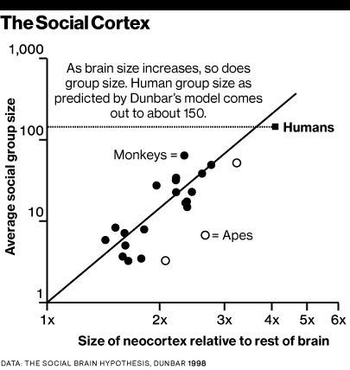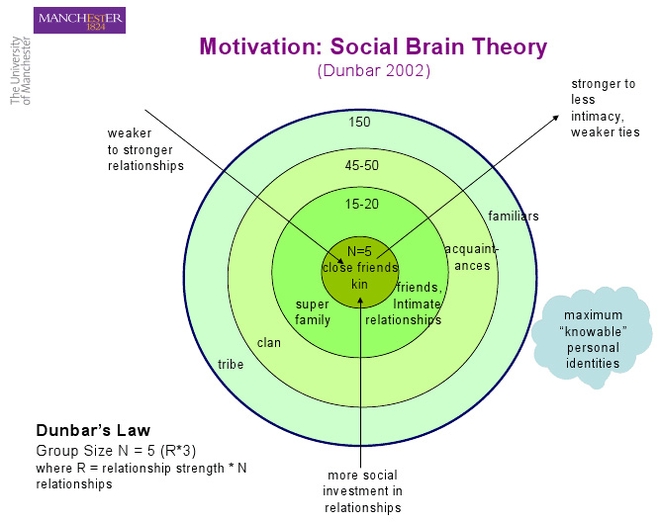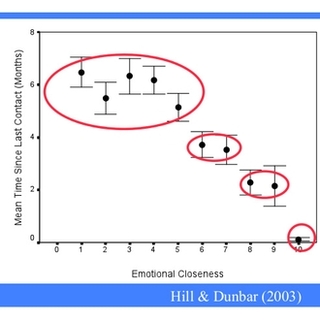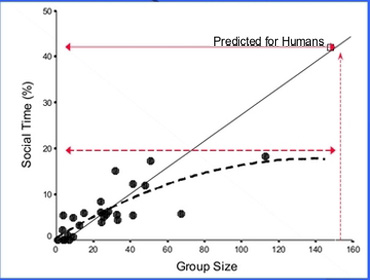~63,100 is the number of hits you will likely get searching google for “Dunbar’s number”. If you are interested in SEO and search for “Dunbar’s number” +SEO you will get 221 results for the last year and 55 results from last month only. What is this number and why SEM/SEO people discuss it?
What is “Dunbar’s number”?

In 1992 Robin Dunbar, currently a Professor of Evolutionary Psychology at the University of Oxford and the director of the Social and Evolutionary Neuroscience Research Group, published a paper in which he proposed that social group size among primates is a function of the relative volume of the neocortex. This became known as the “social brain hypothesis” - the idea that a species that can maintain larger social groups have an evolutionary advantage. In order to be able to maintain a larger social group a species will need additional computing power, that is, a bigger brain.
So, what is the number? Let me illustrate.
In 2003, Russell Hill and Robin Dunbar published a paper in Human Nature examining social network size based on the exchange of Christmas cards. The authors found out that maximum network size averaged 153.5 individuals, with a mean network size of 124.9 for those individuals explicitly contacted; these values are remarkably close to the group size of 150 predicted for humans on the basis of the size of their neocortex. Thus, Dunbar’s number represents a theoretical limit in the size of the social network for humans and is situated around 150 individuals. This the number of people we can have meaningful social relationships. Below is a good graphical representation I found in Google Images (I could not trace the original) of Dunbar’s Social Brain Theory.

Constraints limiting social networks
Dunbar maintains that two factors impact how large a social network we can maintain.
One factor has to do with our cognitive limitations directly - we need to be able to compute complex social problems, such as this “I intend that you believe that Fred understands that we want him to be willing to [do something]... ”.

This is an example of what Dunbar calls a 5th level intentionality problem and is about the limit of what adult humans seem to be able to do on a regular basis.
Above that, things start to become fiendishly complex. However, notice that closely-knit groups (~15 members) are doing 3rd and 4th level computations regularly. We just seem unable and unwilling to do it on a larger scale.
The other factor has to do with time. It time our memories decay and also our emotional attachment decays - two fundamental components that allow us to maintain our social network. On the right side you can see a graph showing the decay of emotional closeness with time since contact (taken from one of Dunbar’s presentations, see below).
Another way in which time affect our ability to maintain a social network has to do with the fact that there is a limited amount of time (after sleep, food, hygiene and work) that we devote to socializing.

For instance, based on primate data relationship between social time and group size, assuming all else is equal, one would expect humans to need to spend a whopping 43% of their time budget on socializing in order to maintain a social network of ~150 relationships. This is of course not the case, as we have (among other things) language to ease our social interactions, but it still shows that time is a critical component of social networks.
If you want entry point into this topic I would highly recommend this presentation or this slideshow by Robin Dunbar.
In the next post I will address the implications Dunbar’s number has for internet marketing and SEO/SEM.






Posting comment as guest.
If you already have an account, please LOGIN.
If not, you may consider creating on. It’s FREE!